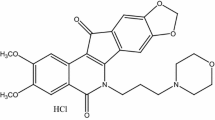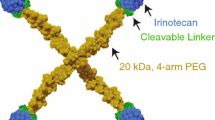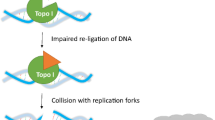Abstract
Purpose: The novel fluoro-substituted camptothecin analog, BMS-286309, and its prodrug, BMS-422461, were evaluated for their pharmacologic, toxicologic, metabolic and pharmacokinetic developmental potential. Methods: In vitro and in vivo assays were used to assess the compounds for topoisomerase I activity, antitumor activity, gastrointestinal (GI) toxicity, and pharmacokinetic parameters. Results: BMS-286309-induced topoisomerase I-mediated DNA breaks in vitro and was similar in potency to camptothecin. Both BMS-286309 and −422461 were comparable to irinotecan regarding preclinical antitumor activity assessed in mice bearing distal site murine and human tumors. BMS-422461 was also found to be orally active. Both analogs were >100-fold more potent in vivo than irinotecan and both were superior to irinotecan with respect to toxicological assessment of GI injury in mice. The generation of parent compound from BMS-422461 was qualitatively similar in mouse, rat and human blood and liver S9 fractions. The percentage of BMS-286309 remaining as the active lactone form at equilibrium was comparable in mouse and human plasma. The pharmacokinetic profile in rat blood demonstrated that BMS-422461 was rapidly cleaved to BMS-286309. Conclusions: The favorable in vivo metabolic activation of BMS-422461, and the pharmacokinetic characteristics of BMS-286309, suggest that the good efficacy of BMS-422461 is derived from robust in vivo release of BMS–286309 in rodents and the likelihood that this biotransformation will be preserved in humans. The comparable antitumor activity of BMS-422461 to irinotecan, as well as reduced preclinical GI toxicity, make this novel camptothecin analog attractive for clinical development.









Similar content being viewed by others
Abbreviations
- AUC:
-
Area under the blood concentration-time curve
- BDC:
-
Bile duct cannulated
- Irinotecan:
-
7-Ethyl-10[4-(1-piperidino)-1-piperidino] carbonyloxycamptothecin
- DMSO:
-
Dimethylsulfoxide
- EC50:
-
Concentration of a compound required to induce topoisomerase I-mediated single-strand breaks in 50% of the DNA substrate
- GI:
-
Gastrointestinal
- HSA:
-
Human serum albumin
- HPLC:
-
High-pressure liquid chromatography
- IC50:
-
Concentration of a compound required to inhibit cell growth by 50% relative to an untreated control
- i.a.:
-
Intraarterial
- i.v.:
-
Intravenous
- LCK:
-
Gross log cell kill
- MSA:
-
Mouse serum albumin
- MTD:
-
Maximum tolerated dose
- PBS:
-
Phosphate buffered saline
- p.o.:
-
Per oral
- s.c.:
-
Subcutaneous
- L:
-
Liters
- Vss:
-
Volume of distribution at steady-state
- SD:
-
Standard deviation
References
Bom D, Curran DP, Chavan AJ, Kruszewski S, Zimmer SG, Fraley KA, Burke TG (1999) Novel A, B, E-ring-modified camptothecins displaying high lipophilicity and markedly improved human blood stabilities. J Med Chem 42:3018–3022
Burke TG, Mi Z (1994) The structural basis of camptothecin interactions with human serum albumin: Impact on drug stability. J Med Chem 37:40–46
Cao S, Black JD, Trout AB, Rustum YM (1998) Interleukin 15 offers selective protection form irinotecan-induced intestinal toxicity in a preclinical animal model. Cancer Res 58:3270–3274
Chabot GG (1997) Clinical pharmacokinetics of irinotecan. Clin Pharmacokinet 33: 245–259
Dodds HM, Haaz MC, Riou JF, Robert J, Rivory LP (1998) Identification of a new metabolite of CPT-11 (Irinotecan): pharmacological properties and activation to SN-38. J Pharmacol Exp Ther 286:578–583
Giovanella BC, Hinz HR, Kozielski AJ, Stehlin JS, Silberm R, Potmesil M (1991) Complete growth inhibition of human cancer xenografts in nude mice by treatment with 20-(S)-camptothecin. Cancer Res 51:3052–3055
Guffroy M, Hodge T (1996) Correspondence regarding irinotecan (CPT-11) and characteristic mucosal changes in the mouse ileum and cecum. J Nat Cancer Inst 88:1240
Hertzberg R, Caranfa MJ, Holden KG, Jakas DR, Gallagher G, Mattern MR, Mong SM, Bartus JO, Johnson RK, Kingsbury WD (1989) Modification of the hydroxylactone ring of camptothecin: inhibition of mammalian topoisomerase I and biological activity. J Med Chem 32:715–720
Ikuno N, Soda H, Watanabe M, Oka M (1995) Irinotecan (CPT-11) and characteristic mucosal changes in the mouse illeum and cecum. J Natl Cancer Inst 87:1876–1883
Lee FY, Borzilleri R, Fairchild CR, Kim SH, Long BH, Reventos-Suarez C, Vite GD, Rose WC, Kramer RA (2001) BMS-247550: a novel epothilone analog with a mode of action similar to paclitaxel but possessing superior antitumor efficacy. Clin Cancer Res 7:1429–1437
Masuda N, Fukuoka M, Kusunoki Y, Matsui K, Takifuji N, Kudoh S, Negoro S, Nishioka M, Nakagawa K, Takada M (1992) CPT-11: a new derivative of camptothecin for the treatment of refractory or relapsed small-cell lung cancer. J Clin Oncol 10:1225–1229
Mathijssen RHJ, van Alphen RJ, Verweij J, Loos WJ, Nooter K, Stoter G, Sparreboom A (2001) Clinical pharmacokinetics and metabolism and irinotecan (CPT-11). Clin Cancer Res 7:2182–2194
Mi Z, Burke TG (1994) Marked interspecies variations concerning the interactions of camptothecin with serum albumins: a frequency-domain fluorescence spectroscopic study. Biochemistry 33:12540–12545
Ohno R, Okada K, Masaoka T, Kuramoto A, Arima T, Yoshida Y (1990) An early phase II study of CPT-11: a new derivative of camptothecin, for the treatment of leukemia and lymphoma. J Clin Oncol 8:1907–1912
Paull KD, Shoemaker RH, Hodes L, Monks A, Scudiero DA, Rubinstein L, Plowman J, Boyd MR (1989) Display and analysis of patterns of differential activity of drugs against human tumor cell lines: development of mean graph and COMPARE algorithm. J Natl Cancer Inst 81:1088–1092
Potmesil M (1994) Camptothecins: from bench research to hospital wards. Cancer Res 54:1431–1439
Rose WC, Clark JL, Lee FYF, Casazza AM (1997) Preclinical antitumor activity of water soluble paclitaxel derivatives. Canc Chemotherap Pharmacol 39:486–492
Takimoto CH, Arbuck SG (1996) The Camptothecins. In: Chabner BA, Longo DA (eds) Cancer chemotherapy and biotherapy, 2nd ed. Lippincott-Raven Publishers, Philadelphia
Wall ME, Wani MC (1980) Camptothecin, anticancer agents based on natural product models. In: Cassadry JM, Douros JD (eds) Academic, New York, pp 417–437
Wentland MP (1991) The structural basis of camptothecin interactions with human serum albumin: Impact on drug stability. Chemtracts-Org Chem 7:238–241
Yoshiaki M, Hiraku O, Akinobu K, Harumi H, Akinobu M, Yoshiharu M (2000) Pharmacokinetics of prolonged-release CPT-11-loaded microspheres in rats. J Control Release 66:159–175
Author information
Authors and Affiliations
Corresponding author
Rights and permissions
About this article
Cite this article
Rose, W.C., Marathe, P.H., Jang, G.R. et al. Novel fluoro-substituted camptothecins: in vivo antitumor activity, reduced gastrointestinal toxicity and pharmacokinetic characterization. Cancer Chemother Pharmacol 58, 73–85 (2006). https://doi.org/10.1007/s00280-005-0128-y
Received:
Accepted:
Published:
Issue Date:
DOI: https://doi.org/10.1007/s00280-005-0128-y




